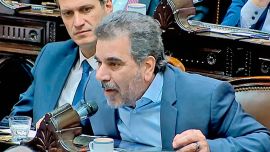There are few places in all of Argentina as poor as La Rioja, a sleepy, desolate province carved out of the red-clay highlands that form the country’s northwestern border with Chile.
And it is here, in La Rioja, that the financial toll of President Javier Milei’s shock economic therapy — a high-stakes bid to tame chronic inflation — can best be observed. When Milei slashed the monthly cash transfers from the federal government to the provinces, La Rioja went broke. In February, it fell into default. And soon the local economy had sunk into a deep recession.
So the governor, an outspoken critic of Milei by the name of Ricardo Quintela, dialled up a radical plan of his own. He created the province’s own currency, the chacho, had sheets of it printed up and started doling it out in wads of 50,000 to all government employees. It was a little bonus payment, Quintela said, to help people buy more of the essentials they’d been skimping on. Shop owners weren’t outright forced, but rather strongly encouraged, to accept chachos just like they would pesos. One chacho equals one peso.
On a chilly morning in late August, the province’s workers bundled up in heavy jackets and hurried to get into line to collect their new currency. There was some grumbling as morning turned to afternoon and the line crawled along at a glacial pace — “seven hours to collect 50,000 filthy chachos,” one groused — but the mood was generally light. They made small talk and sipped mate. The payment they were due, equal to some US$40, was a lot of money in a province where the average monthly salary is just US$240.
Chachos finally in hand, they wasted no time in spending them.
At Refinor, a gas station in the provincial capital city, business jumped 10 percent that morning. And over at Noed-Fama, a little corner butcher shop, about half of all customers paid that first week with the new currency. Juan Bonaldi, a cashier there, said the shop owners, leery of getting stuck with too many chachos, had concocted their own (very detailed) rules: customers will only receive change in pesos if the purchase price of the meat they’re buying equals at least 80 percent of the value of the chachos they’re handing over. Change will otherwise be provided in chachos or, when not possible, the order cancelled.
Quintela has pointed merchants eager to get rid of their chachos to the two government offices in the capital city that will, after a 48-hour mandatory wait, exchange them for pesos. Wait all the way till December, Quintela has told them, and the provincial government will pay them 1.17 pesos for each chacho, effectively an interest rate of 17 percent in pesos that, when annualised, comes to over 50 percent.
This illustrates the essence of what the whole chacho scheme ultimately is: a way for a deadbeat province that has been cut off from federal funds and locked out of debt markets at home and abroad to obtain financing and keep spending.
Even in a country renowned for its bloated public sector, La Rioja stands out.
Controlled by the leftist Peronist party that’s run the country for most of this century, the government employs two out of every three workers in the province. And it owns dozens of companies — miners, vineyards, poultry farms, glassmakers — through which it controls much of the local economy. As Milei began his frantic bid to break from that Peronist economic model and turn the country around, it was perhaps inevitable that La Rioja would be the first to crack. Critics of the provincial government tar it with a damning label: Venezuela.
Mariana Chanampa, vice-president of a business chamber outside the capital city of La Rioja, says the way people are willing to stand in line for hours “to collect a handout that will allow them to eat” for a few days demonstrates how apt the Venezuela comparison is. The chacho, she says, “is a reflection of that poverty.”
Press officials for the governor declined to comment on the rollout of the currency.
Ángel Vicente ‘Chacho’ Peñaloza is a legend around here. Monuments to him dot the landscape. In most of them, Chacho, a fierce local caudillo who, fittingly, made his name fighting against forces from Buenos Aires during the 19th-century civil wars, strikes a menacing pose, spear slung over his shoulder, as he commands his troops.
This is the rugged image that adorns the new bills. There’s also a QR code on each bill which, when scanned, displays a sharply worded message blasting the Milei government for starving the province of the federal funds it’s due.
The chachos come in denominations of 1,000 to 50,000. Some three billion of them, or roughly US$3 million, have been handed out, with plans to soon boost that amount to nine billion. Small stuff for now but a sign, pundits say, of what’s to come both in La Rioja and, perhaps, across the nation. If the gambit seems to be working in La Rioja — or at least winning Quintela political points — other governors could follow.
“Who is to say that another governor will not do something similar?” says Nicolás Casas, an economics professor at Universidad Nacional de La Rioja. He doubts any will try it soon but support for the idea, he says, could begin to build. “This is like a snowball.’’
It’s happened before. Back in the early 2000s, as the federal government imposed an austerity plan on the country similar to Milei’s today, provinces rushed to issue their own currencies. In total, more than a dozen provinces, including La Rioja, joined in. (La Rioja had also tried it in the 1980s.)
The currencies met with mixed success as the country sank deeper into crisis before they were all swapped out for pesos by the new Peronist government that swept into office in Buenos Aires in 2003.
Milei has said little about the chacho but indicated that, true to his libertarian philosophy, he will neither try to ban it, as some of his allies have urged, nor offer to swap it out for pesos. “No way,” he posted on X when Quintela first began talking about the chacho.
The one chacho-to-one peso exchange rate is meant to be iron-clad. Quintela has said that while stores can refuse to take chachos, they can’t impose a discount when accepting them as payment. Violators, he’s promised, will be closed down.
It’s a hard rule to enforce, though. The chacho has obvious limitations. “You have to travel all over to see which stores will take them,” Edith Leguize, a teacher, said after collecting her 50,000 chachos. And they’re of no use, of course, for anyone travelling into surrounding provinces.
There are restrictions for business owners, too, like on paying worker salaries with them. So many stores only give out credit vouchers as change to customers who pay with chachos. And some websites have begun to pop up offering to buy chachos at a 10 percent discount.
Chanampa, the business chamber leader, says she’s been struck by the speed with which Riojanos spend the chachos when they get them. They remember, she says, how previous local-currency experiments and other handout schemes flopped, leaving them with greatly devalued pieces of paper.
“They’re afraid it’s going to happen to them again,” says Chanampa. “This is just a band-aid. It doesn’t solve the problem.”
by Ignacio Olivera Doll, Bloomberg
























Comments